International Journal of Intelligent Systems and Applications @ijisa
Статьи журнала - International Journal of Intelligent Systems and Applications
Все статьи: 1214
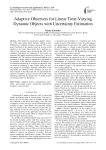
Adaptive Observers for Linear Time-Varying Dynamic Objects with Uncertainty Estimation
Статья научная
The method for construction adaptive observ-ers (AO) time-varying linear dynamic objects at non-fulfillment of condition excitation constancy (EC) is pro-posed. Synthesis of the adaptive observer is given as the solution of two tasks. The solution first a problem is a choice of the constant matrix decreasing the effect of EC condition. Procedures for obtaining of this matrix are proposed. The matrix specifies restrictions for a vector of parameters AO. The solution of the second problem gives a method of design adaptive multiplicative algorithms in the presence of the obtained restrictions. Procedures for an estimation uncertainty in an object are proposed. They are based on obtaining of static models giving the forecast change of uncertainty. Optimum estimations of the uncertainty are obtained which minimize an error between outputs of the object and AO. An exponential dissipativity of adaptive system is proved. The results of the modeling confirming the effectiveness of designed methods and procedures are presented.
Бесплатно
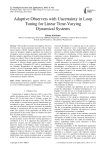
Adaptive Observers with Uncertainty in Loop Tuning for Linear Time-Varying Dynamical Systems
Статья научная
The method of construction adaptive observers for linear time-varying dynamical systems with one input and an output is offered. Adaptive algorithms for identification are designed. Adaptive algorithms not realized as an adaptive system contains parametric uncertainty (PU). Realized adaptive algorithms of identification parameters system are offered. They on the procedure of the estimation PU and algorithm of signal adaptation are based. The algorithm of velocity change system parameters estimation is proposed. Estimations PU and its misalignments are obtained. Boundedness of trajectories an adaptive system is proved. Exponential stability conditions of the adaptive system are obtained. Iterative procedure of construction a parametric restrictions area is proposed. Simulation results have confirmed the efficiency of the method construction an adaptive observer.
Бесплатно
Статья научная
This paper proposes a novel metaheuristic optimization algorithm and suggests an adaptive artificial neural network controller that based on the proposed optimization algorithm. The purpose of the neural controller is to track desired proposed velocities and path trajectory with the minimum error, in the presence of mobile robot parameters time variation and system model uncertainties. The proposed controller consists of two sub-neural controllers; the kinematic neural feedback controller, and the dynamic neural feedback controller. The external feedback kinematic neural controller was responsible of generating the velocity tracking signals that track the mobile robot linear and angular velocities depending on the robot posture error, and the desired velocities. On the other hand, the internal dynamic neural controller has been used to enhance the mobile robot against parameters uncertainty, parameters time variation, and disturbance noise. However, the proposed grass root population-based metaheuristic optimization algorithm has been used to optimize the weights of the neural network to have the behavior of an adaptive nonlinear trajectory tracking controller of a differential drive wheeled mobile robot. The proposed controller shows a very good ability to prepare an appropriate dynamic control left and right torque signals to drive various mobile robot platforms using the same offline optimized weights. Grass root optimization algorithms have been used due to their unique characteristics especially, theirs derivative free, ability to optimize discretely and continuous nonlinear functions, and ability to escape of local minimum solutions.
Бесплатно
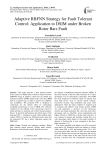
Статья научная
This paper presents a fault tolerant control (FTC) based on Radial Base Function Neural Network (RBFNN) using an adaptive control law for double star induction machine (DSIM) under broken rotor bars (BRB) fault in a squirrel-cage in order to improve its reliability and availability. The proposed FTC is designed to compensate for the default effect by maintaining acceptable performance in case of BRB. The sufficient condition for the stability of the closed-loop system in faulty operation is analyzed and verified using Lyapunov theory. To proof the performance and effectiveness of the proposed FTC, a comparative study within sliding mode control (SMC) is carried out. Obtained results show that the proposed FTC has a better robustness against the BRB fault.
Бесплатно
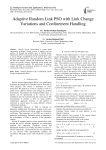
Adaptive Random Link PSO with Link Change Variations and Confinement Handling
Статья научная
Particle Swarm Optimization is swarm based optimization technique. Swarm consists of particles and the particles fly through the problem space in Particle Swarm Optimization (PSO). Confinement methods and parameters such as Inertia Weight, Neighborhood of the particle have major impact on PSO performance. The paper presents variations of the PSO with adaptive random link neighborhood. The work carried out considers linearly decreasing inertia weight and different confinement methods. The performance of adaptive random link PSO by geometrical updation of velocity with confinement methods is tested here.
Бесплатно
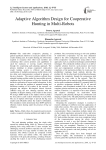
Adaptive algorithm design for cooperative hunting in multi-robots
Статья научная
The multi-robot cooperative planning is gained significant attention in recent past mainly for the evaders hunting task. In evaders hunting, the robot nodes required to recognize their other team members and considering their current positions and capabilities to catch the stationary or moving evaders effectively through the cooperating path planning approach. The primary challenge to design cooperative multi-robot evader hunting system is efficient and adaptive coordination of multiple autonomous mobile robots with less delay and communication overhead in presence of big-size obstacles. The current solutions suffered from repeated hunting problem under the inaccessible network conditions due to the presence of big-size obstacles and ineffective utilization of known nodes information. In this paper, to alleviate the problem of repeated hunting and inefficient catching of all evaders in the network, we proposed the adaptive Bio-inspired Neural Network (ABNN) using the new shunting equation with the capability of adaptive hunting of all evaders in the system. We design ABNN based on the implicit robot to predict the next path to catch evaders efficiently by real robots. The use of implicit robot helps to prevent the big sized evaders and efficiently utilize the evader’s information. The simulation results demonstrate that ABNN performs efficient evaders hunting under the presence of big size obstacles.
Бесплатно
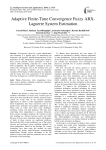
Adaptive finite-time convergence fuzzy ARX-laguerre system estimation
Статья научная
Convergence speed for system identification and estimation is a popular topic for determining the kinematics and dynamic identification/estimation of the parameters of robot manipulators. In this paper, adaptive fuzzy inverse dynamic system estimation is used to improve robust modeling, especially for a serial links robot manipulator. The Lyapunov technique is used to analyze the convergence rate of the tracking error and increase the accuracy response of the parameter estimation. Performance of robot estimation is conducted, and the results show fast convergence of the proposed finite time technique for a 6-DOF robot manipulator.
Бесплатно
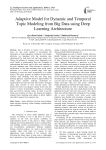
Статья научная
Due to freedom to express views, opinions, news, etc and easier method to disseminate the information to large population worldwide, social media platforms are inundated with big streaming data characterized by both short text and long normal text. Getting the glimpse of ongoing events happening over social media is quintessential from the viewpoint of understanding the trends, and for this, topic modeling is the most important step. With reference to increase in proliferation of big data streaming from social media platforms, it is crucial to perform large scale topic modeling to extract the topics dynamically in an online manner. This paper proposes an adaptive framework for dynamic topic modeling from big data using deep learning approach. Approach based on approximation of online latent semantic indexing constrained by regularization has been put forth. The model is designed using deep network of feed forward layers. The framework works in an adaptive manner in the sense that model is extracts incrementally according to streaming data and retrieves dynamic topics. In order to get the trends and evolution of topics, the framework supports temporal topic modeling, and enables to detect implicit and explicit aspects from sentences also.
Бесплатно
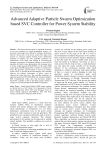
Advanced Adaptive Particle Swarm Optimization based SVC Controller for Power System Stability
Статья научная
The interconnected systems is continually increasing in size and extending over whole geographical regions, it is becoming increasingly more difficult to maintain synchronism between various parts of the power system. This paper work presents an advanced adaptive Particle swarm optimization technique to optimize the SVC controller parameters for enhancement of the steady state stability & overcoming the premature convergence & stagnation problems as in basic PSO algorithm & Particle swarm optimization with shrinkage factor & inertia weight approach (PSO-SFIWA). In this paper SMIB system along with PID damped SVC controller is considered for study. The generator speed deviation is used as an auxiliary signal to SVC, to generate the desired damping. This controller improves the dynamic performance of power system by reducing the steady-state error. The controller parameters are optimized using basic PSO, PSO-SFIWA & Advanced Adaptive PSO. Computational results show that Advanced Adaptive based SVC controller is able to find better quality solution as compare to conventional PSO & PSO-SFIWA Techniques.
Бесплатно
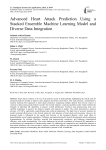
Статья научная
Heart attacks continue to be one of the primary causes of death globally, highlighting the critical need for advanced predictive models to improve early diagnosis and timely intervention. This study presents a comprehensive machine learning (ML) approach to heart attack prediction, integrating multiple datasets from diverse sources to construct a robust and accurate predictive model. The research employs a stacking ensemble model, which combines the strengths of individual ML algorithms to improve overall performance. Extensive data preprocessing steps were carefully undertaken to preserve the dataset's integrity and maintain its quality. The results demonstrate a superior accuracy of 97.48%, significantly outperforming state-of-the-art approaches. The high level of accuracy indicates the model’s potential effectiveness in the clinical setting for early detection of heart attack and prevention. However, the proposed model is influenced by the quality and diversity of the integrated datasets, which could affect its generalizability across broader populations. Challenges encountered during the model's development include optimizing hyperparameters for multiple classifiers, ensuring data preprocessing consistency, and balancing computational efficiency with model interpretability. The results underscore the pivotal contribution of advanced ML approaches in revolutionizing the management of cardiovascular attack. By addressing the complexities and variabilities inherent in heart attack prediction, the work provides a pathway towards more effective and personalized cardiovascular disease management strategies, demonstrating the transformative potential of ML in healthcare.
Бесплатно
Advanced Mobile Surveillance System for Multiple People Tracking
Статья научная
The paper develops an efficient people surveillance system capable of tracking multiple people on different terrains. Recorded video on rough terrains is affected by jitters resulting into significant error between the desired and captured video flow. Video stabilization is achieved by calculating the motion and compensational parameters using the LSE analytical solution to minimize the error between present and desired output video captured from an autonomous robot’s camera moving on a rough terrain used for surveillance of unidentified people. This is the first paper to the best of our knowledge which makes use of this method to design mobile wireless robot for human surveillance applications. As the method used is fast then conventional methods, making the proposed system a highly efficient surveillance system as compared to previous systems. The superiority of the method used is demonstrated using different evaluation parameters like RMCD, variability and reliability. The system can be used for surveillance of people under different environmental conditions.
Бесплатно
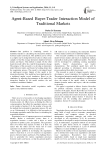
Agent-Based Buyer-Trader Interaction Model of Traditional Markets
Статья научная
One problem in simulating crowds in traditional markets is calculating the interaction duration between traders and buyers. This problem can be solved in a simple way by doing field observation to obtain some samples to find the average interaction duration between traders and buyers. This method is simple. On the other hand, the result will be less valid if the parameters are change. The purpose of this research is to develop an interaction model between traders and buyers by looking deeper into the negotiation process. This model is developed based on multi-agent system. Output of this model is the interaction duration. This model has been implemented in a traditional market crowd simulation. Based on the simulation, by adjusting the parameters in this model, the interaction duration by the model matches the real condition in traditional markets.
Бесплатно
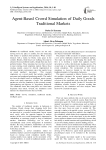
Agent-Based Crowd Simulation of Daily Goods Traditional Markets
Статья научная
In traditional market, buyers are not only moving from one place to another, but also interacting with traders to purchase their products. When a buyer interacts with a trader, he blocks some space in the corridor. Besides, while buyers are walking, they may be attracted by non-preferred traders, though they may have preferred traders. These situations have not been covered in most existing crowd simulation models. Hence, these existing models cannot be directly implemented in traditional market environments since they mainly focus on crowd members' movement. This research emphasizes on a crowd model that includes simplified movement and unplanned purchasing models. This model has been developed based on intelligent agent concept, where each agent represents a buyer. Two traditional markets are used for simulation in this research, namely Gedongkuning and Ngasem, in Yogyakarta, Indonesia. The simulation shows that some places are visited more frequently than others. Overall, the simulation result matches the situation found in the real world.
Бесплатно
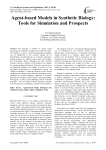
Agent-based Models in Synthetic Biology: Tools for Simulation and Prospects
Статья научная
We describe a multiset of agents based modeling and simulation paradigm for synthetic biology. The multiset of agents –based programming paradigm, can be interpreted as the outcome arising out of deterministic, nondeterministic or stochastic interaction among elements in a multiset object space, that includes the environment. These interactions are like chemical reactions and the evolution of the multiset can emulate the system biological functions. Since the reaction rules are inherently parallel, any number of actions can be performed cooperatively or competitively among the subsets of elements, so that the elements evolve toward equilibrium or emergent state. Practical realization of this paradigm for system biological simulation is achieved through the concept of transactional style programming with agents, as well as soft computing (neural- network) principles. Also we briefly describe currently available tools for agent-based-modeling, simulation and animation.
Бесплатно
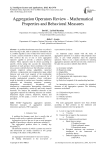
Aggregation Operators Review - Mathematical Properties and Behavioral Measures
Статья научная
A problem that humans must face very often is that of having to add, melt or synthesize information, that is, combine together a series of data from various sources to reach a certain conclusion or make a certain decision. This involves the use of one or more aggregation operators capable to provide a collective preference relation. These operators must be chosen according to specific criteria taking into account the characteristic properties of each operator. Some conditions to be taken into account to identify them are the following: axiomatic strength, empirical setting, adaptability, numerical efficiency, compensation and compensation range, added behavior and scale level required of the membership functions. It is possible to establish a general list of possible mathematical properties whose verification might be desirable in certain cases: boundary conditions, continuity, not decreasing monotony, symmetry, idempotence, associativity, bisymmetry, self-distributivity, compensation, homogeneity, translativity, stability, ϕ-comparability, sensitivity and locally internal functions. For analyze the attitudinal character of the aggregation operator the following measures are studied: disjunction degree (orness), dispersion, balance and divergence. In this paper, a review of these issues is presented.
Бесплатно
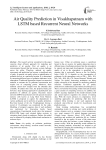
Air quality prediction in Visakhapatnam with LSTM based recurrent neural networks
Статья научная
The research activity considered in this paper concerns about efficient approach for modeling and prediction of air quality. Poor air quality is an environmental hazard that has become a great challenge across the globe. Therefore, ambient air quality assessment and prediction has become a significant area of study. In general, air quality refers to quantification of pollution free air in a particular location. It is determined by measuring different types of pollution indicators in the atmosphere. Traditional approaches depend on numerical methods to estimate the air pollutant concentration and require lots of computing power. Moreover, these methods cannot draw insights from the abundant data available. To address this issue, the proposed study puts forward a deep learning approach for quantification and prediction of ambient air quality. Recurrent neural networks (RNN) based framework with special structured memory cells known as Long Short Term Memory (LSTM) is proposed to capture the dependencies in various pollutants and to perform air quality prediction. Real time dataset of the city Visakhapatnam having a record of 12 pollutants was considered for the study. Modeling of temporal sequence data of each pollutant was performed for forecasting hourly based concentrations. Experimental results show that proposed RNN-LSTM frame work attained higher accuracy in estimating hourly based air ambience. Further, this model may be enhanced by adopting bidirectional mechanism in recurrent layer.
Бесплатно
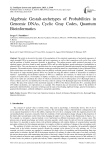
Статья научная
The article is devoted to the study of the regularities of the statistical organization of nucleotide sequences of single-stranded DNAs in genomes of higher and lower organisms, as well as their connections with cyclic Gray codes and the problem of holistic structures (gestalts) in physiology. The author presents stable statistical structures of an algebraic nature, which are found in many genomic DNAs and are called algebraic gestalt-archetypes of probabilities in genomic DNAs. They are discussed as a possible basis for several genetically inherited physiological and psychophysical properties. The numerical rules of these genomic archetypes realized in nature for a representative class of genomic DNAs, whose initial data were taken by the author from the publicly available genomic data bank “GenBank”, are formulated. The analysis of single-stranded genomic DNAs was carried out using the author's method of "hierarchies of multilayer statistics", representing the nucleotide sequence of DNA as a multilayer text structure, in which each n-th layer is a sequence of n-plets (that is, of monoplets, or duplets, or triplets, etc.). In each such layer, the percentages of each of the types of its n-plets are calculated, the values of which are inserted into the so-called genetic (2n∙2n) Karnaugh matrices, whose columns and rows are numbered by n-bit Gray codes by analogy with Karnaugh maps from the Boolean algebra of logic. The data of the analysis of the nucleotide sequence of DNA of the human chromosome № 1, containing about 250 million nucleotides, are represented as an example. The obtained data are discussed in light of the problem of genetically inherited holistic structures in biology and the tasks of developing algebraic biology, genetic biomechanics, quantum bioinformatics, artificial intelligence, and genetic algorithms.
Бесплатно
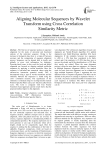
Aligning molecular sequences by wavelet transform using cross correlation similarity metric
Статья научная
The first fact of sequence analysis is sequence alignment for the study of structural and functional analysis of the molecular sequence. Owing to the increase in biological data, there is a trade-off between accuracy and the computation of sequence alignment process. Sequences can be aligned both in locally and globally to gives vital information for biologists. Focusing these issues, in this work the local and global alignment are focused on aligning multiple molecular sequences by applying a wavelet transform. Here, the sequence is converted into numerical values using the electron-ion interaction potential model. This is decomposed using a type of wavelet transform and the similarity between the sequences is found using the cross- correlation measure. The significance of the similarity is evaluated using two scoring function namely Position Specific Matrix and a new function called Count score. The work is compared with Fast Fourier Transform based approach and the result shows that the proposed method improves the alignment.
Бесплатно
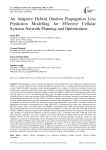
Статья научная
The frequent poor service network experienced by some mobile phone users within some deadlock areas in Nigeria is an issue which has been identified by different researchers due to wrong positioning and planning of the evolved NodeB (eNodeB) transmitter using existing propagation loss models. To effectively contribute towards this potential issue constantly experienced in some part of Nigeria, an adaptive hybrid propagation loss model that is based on wavelet transform and genetic algorithm methods has been developed for cellular network planning and optimization, with the capacity to resolve the problems absolutely. First, the signal strengths were measured within four selected eNodeB cell sites in long term evolution (LTE) at 2600MHz using drive-test method. Secondly, the measured data were denoised through wavelet tools. Thirdly, COST231 model was optimize and deduced to generic model with parameters. Fourthly, genetic optimization algorithm automatically developed the propagation loss models for denoised signal data (designated as wavelet-GA model) and unprocessed signal data (designated as GA model). The hybrid wavelet-GA propagation loss model, GA propagation loss model, and COST231 propagation loss model were compared based on three error metrics such as root mean square error (RMSE), mean absolute error (MAE) and correlation coefficient (R). The developed hybrid wavelet-GA model estimated the lowest RMSEs of 2.8813 dB, 3.9381 dB, 4.7643 dB, 6.9366 dB, whereas, COST231 model gave highest value of RMSE. The developed hybrid wavelet-GA model also derived the least value of MAE as compared with COST231 and the GA models, such as, 2.2016 dB, 2.8672 dB, 3.4766 dB, 5.8235 dB. The correlation coefficients were also compared, and it showed that the developed hybrid wavelet-GA model were 90.04%, 78.61%, 92.21% and 91.23% for the four cell sites. The developed hybrid wavelet-GA model was also validated to account for the performance level by checking for the correlation coefficient using another measured signal data from different eNodeB cell sites other than the once used for the developed of the hybrid wavelet-GA model. It was noticed that the developed hybrid wavelet-GA propagation loss model is 97.41% valid. Existing standard COST231 model are not able to predict propagation loss with high level of accuracy, as such not efficient to be applied within part of Port Harcourt, Nigeria. The proposed hybrid wavelet-GA model has proven to achieve high performance level and it is relevant to be utilized for cellular network planning and optimization. In future purposes, more regions and locations should be considered to form a broader view in the development of more robust propagation loss models.
Бесплатно
An Algorithm for Detecting the Minimal Sample Frequency for Tracking a Preset Motion Scenario
Статья научная
Inertial sensors are used for human motion capture in a wide range of applications. Some kinds of human motion can be tracked by inertial sensors incorporated in smartphones or smartwatches. However, the latter can scarcely be used if misclassification of user activities is highly undesirable. In this case electronics and embedded software engineers should design, implement and verify their own human motion capture embedded systems, and oftentimes they have to do so from scratch. One of the issues the engineers should face is selection of suitable components, primarily accelerometers, gyroscopes and magnetometers, after thorough examination of commercially available items. Among technical characteristics of inertial sensors their sample frequency determines whether the sensor will be able to capture a specific motion kind or not. We propose a novel algorithm that allows the researcher or embedded software engineer to calculate the minimal sample frequency sufficient for tracking a prescribed motion scenario without significant signal losses. The algorithm utilizes the Poisson equation for motion of a triaxial rigid body, the Shoemake’s algorithm for interpolating quaternions on the unit hypersphere, and the frequency analysis of a discrete-time signal. One can use the proposed algorithm as an argument for acceptance or rejection of a gyroscope when selecting hardware components for a human motion tracking system.
Бесплатно

